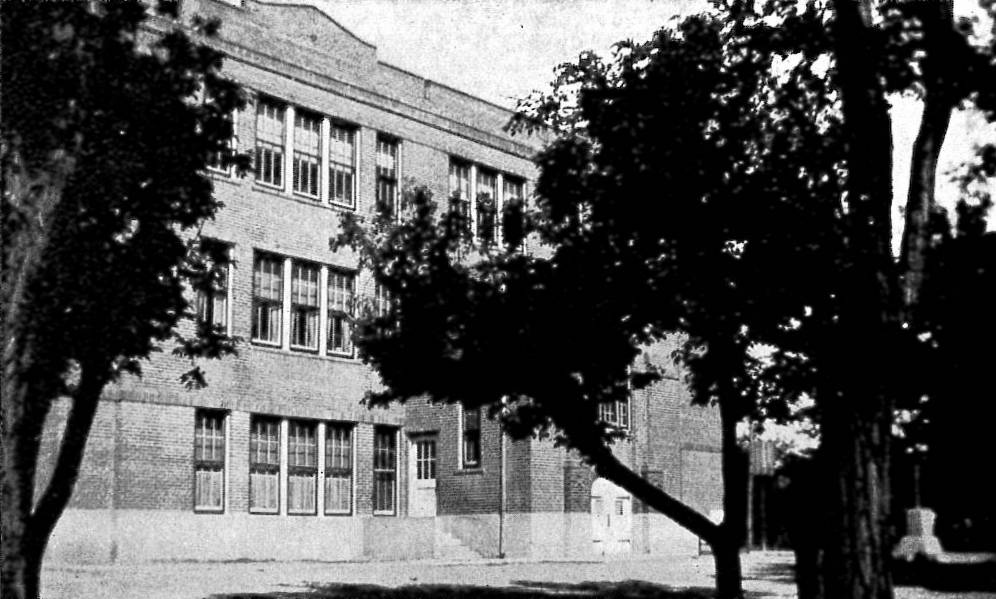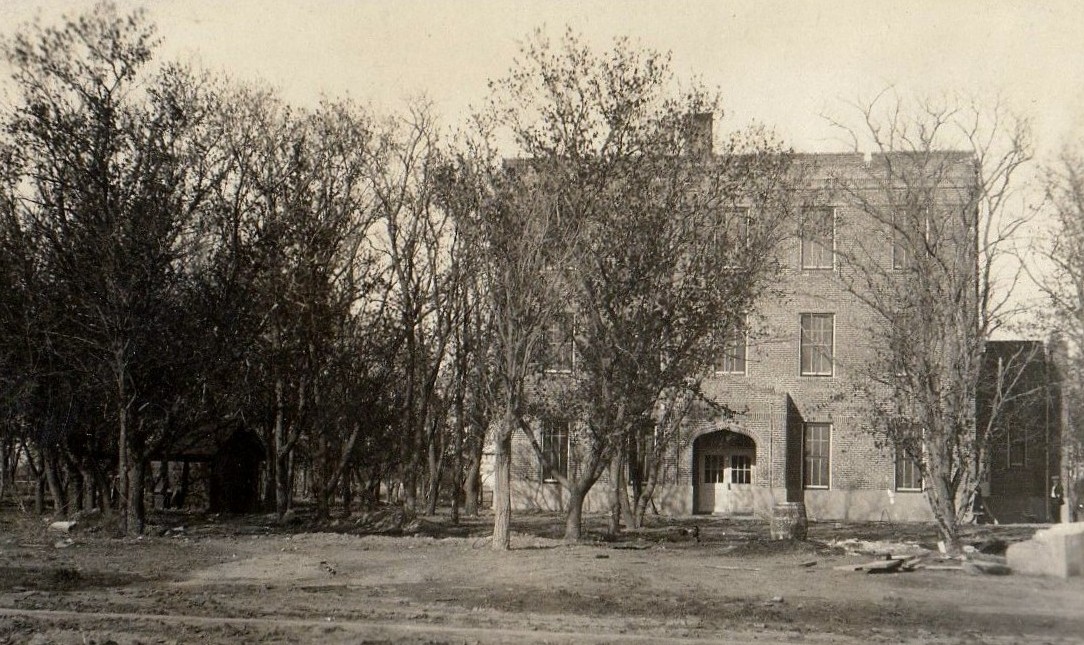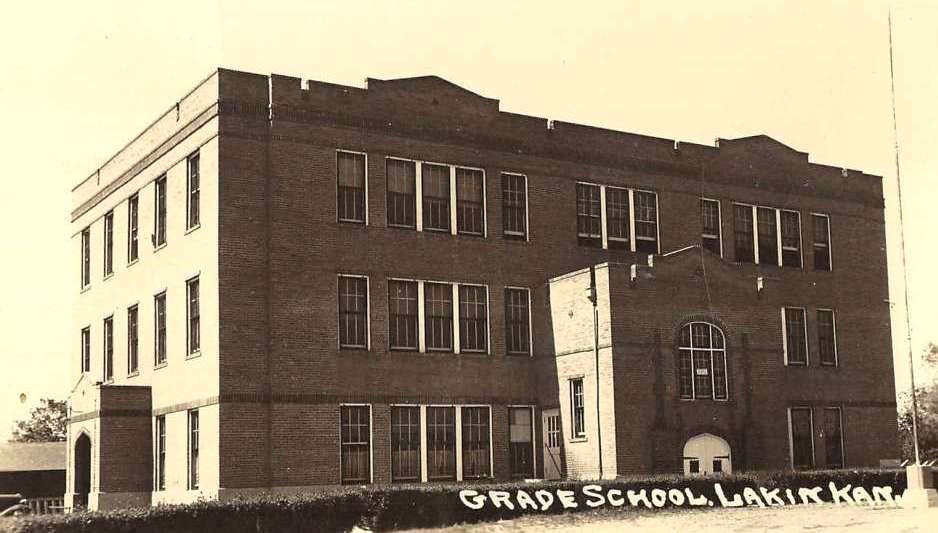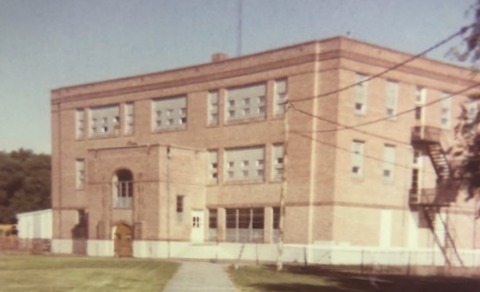When Lakin’s students headed back to school in 1920, they didn’t have a school house to go to. The 1886 school building had been impressive and a testament to the importance of education to our founding fathers, but the school’s stone foundation had become unstable by 1919. The walls of the building were laid to the ground in May 1920, and workers began clearing off the debris so that a new school could be started immediately in its place. Students started off the 1920-1921 school year by meeting for class in other buildings. High schoolers met in the courthouse while the primary grades were divided among three of the churches in town. Seventh and eighth graders started off in the Willis & Eves land office, but within a matter of days, the two grades were moved to the Knights and Ladies of Security Hall on the upper story of the building that still remains at 112 N. Main.
The cornerstone of the 1920/1921 school was laid in July of 1920 in an impressive service which featured addresses, music and prayer. The foundation of the school was done at that time, but it was late March 1921 before the school was completed. The primary grades and high school moved in first followed by seventh and eighth grades a few days later. The April 1, 1921 Advocate proclaimed, “When the school bell rang Monday morning the children were not obliged to run hither and yon to take up their studies but proceeded direct to the school house, once more our city school is under one roof.”
Voters passed a $43,000 school bond election in June 1919 to build the school, but found the amount insufficient after reviewing bids for the building. Voters went back to the polls in March of 1920 and voted an additional $26,800 in school bonds. The building had three floors and fronted to the south facing Prairie Street with the main entrance leading directly to an auditorium and gymnasium. A smaller entrance on each side of the main entrance led to the first floor. The splendid brick and concrete building was modern in every respect from electric lights to heating and plumbing methods. Although Lakin did not have water or sewer systems until 1926, a pressure pump was put on the soft water well to supply water, and a cesspool was dug for sewage disposal. Gas was not installed until after 1936 which meant the custodian had to be on the job by four or five o’clock in the morning during cold weather to awaken the coal furnace.
 The Class of 1921 was the first to graduate from the new building which was surrounded by the beautiful school park. The much-loved grove of trees had been planted by A.W. Sudduth, a custodian of the 1886 building and was a popular place for community picnics and gatherings.
The Class of 1921 was the first to graduate from the new building which was surrounded by the beautiful school park. The much-loved grove of trees had been planted by A.W. Sudduth, a custodian of the 1886 building and was a popular place for community picnics and gatherings.
When the building was built, board and community members believed that the school would accommodate future growth and changing conditions, but within 10 years the school was crowded. On April 11, 1930, the school had an enrollment of 218 in the primary grades and 103 in the high school. To combat the overcrowding, a plan was proposed at the annual school meeting to organize a rural high school and retain the 1920/1921 school building for primary grades through eighth grade exclusively.

A population boom created by the expansion of the natural gas, oil and irrigation industries in the area led to overcrowding again by the late 40s. In 1949, kindergarten through fifth grade moved out of the building and into the new grade school building, leaving only sixth through eighth grades in the 1920/1921 building which then became commonly known as the “junior high school.”
Fifty years after the school’s completion, only seventh and eighth grades were using the old school when part of the ceiling on the third floor gave way and crashed to the floor in April 1971. Fortunately, no students or staff were in the building. Harold Smith, teacher and a substitute bus driver, took his briefcase up to the third floor that morning where his classroom was, placed it on his desk, and left. Harold said the ceiling was still intact at that time. When he returned after driving his bus route, there were police officers and people on the lawn panicking. The ceiling in his classroom had collapsed first, and the library’s ceiling did the same soon after. The plaster fell from the 12-foot ceilings, and most of it was from one to one and one-half inches thick and carried considerable weight which could have easily caused severe injuries or even death.

Bill Adams and George Sauer, Jr., both members of Lakin High’s Class of 1975, vividly recall the incident. Adams said he remembered coming to school that morning after the ceiling gave way in his home room. “We carried desks down to the lower floors. The ceiling had metal lathe, and there was a pretty deep gouge in the top of my desk from the metal.” Sauer said a classmate’s desk was completely flattened. “We held the last 9 weeks of school in the grade school gym.”
Experts were brought in to determine if the structure could be saved, but the building did not pass the test and was torn down. The school’s bell was saved and is now on display at the Kearny County Museum outside our one-room schoolhouse. When the decision was reached to raze the 1886 building, F.M. Hyames, superintendent of schools, announced that contractors were to take as much of the old school as possible to re-use in the 1920/1921 building. Could this mean the 28” Goulds bell that was donated to the Museum was also used in the 1886 school? Museum staff researched vintage Goulds Manufacturing catalogs and discovered that bells like ours were advertised in several catalogs from the late 1800s. We reached out to Goulds Manufacturing as well as experts in the field who collect, refurbish and sell school bells and hope to have an answer soon.

SOURCES: Archives of The Advocate and Lakin Independent; History of Kearny County Vol. I; Facebook; museum archives; GoogleBooks; and a personal account by the late Harold Smith, former teacher and Kearny County Museum Director.
